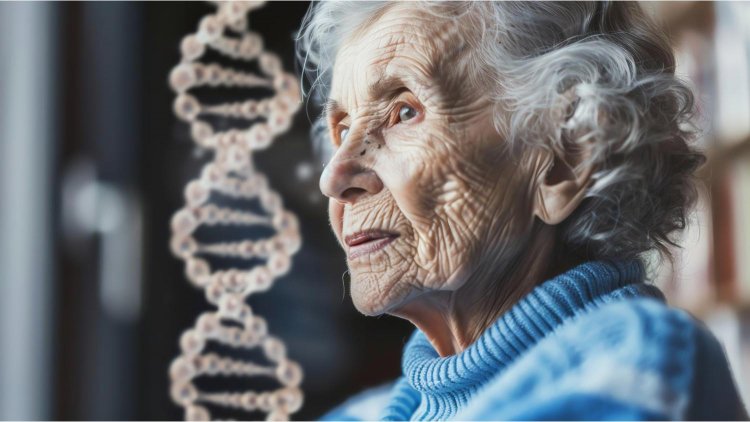The Genetic Architecture of Aging: A Complex Network
The process of aging is a highly complex and multifaceted phenomenon, influenced by an interplay of genetic, environmental, and lifestyle factors. At the heart of this process is the gradual accumulation of cellular damage, which can lead to the decline of physiological functions and increase the risk of age-related diseases. Genetics plays a crucial role in this process, with certain genes being directly involved in the regulation of aging and longevity.
Research has identified several key genetic pathways that influence aging, including those involved in DNA repair, oxidative stress response, and cell cycle regulation. For instance, the sirtuin family of genes, particularly SIRT1, has been shown to play a significant role in promoting longevity and protecting against age-related diseases. These genes are involved in various cellular processes, such as DNA repair and the regulation of inflammatory responses, which are critical in mitigating the effects of aging.
Another important genetic factor in aging is telomere length. Telomeres are protective caps at the ends of chromosomes that shorten with each cell division. Over time, as telomeres become critically short, cells enter a state of senescence, leading to tissue dysfunction and the onset of age-related diseases. Genetic variations that affect telomere maintenance can significantly influence an individual's aging process and susceptibility to diseases such as cardiovascular disease, cancer, and neurodegenerative disorders.
Age-Related Diseases and Their Genetic Underpinnings
As we delve deeper into the role of genetics in age-related diseases, it becomes evident that our genes can both predispose us to certain conditions and offer protection against others. Let's explore some of the most common age-related diseases and the genetic factors that contribute to their development.
1. Cardiovascular Diseases
Cardiovascular diseases (CVDs) are among the leading causes of morbidity and mortality in older adults. The risk of developing conditions such as coronary artery disease, hypertension, and stroke increases significantly with age. While lifestyle factors such as diet, exercise, and smoking play a major role in the development of CVDs, genetics also has a substantial impact.
Several genetic variants have been linked to an increased risk of CVDs. For instance, polymorphisms in the APOE gene, particularly the APOE ε4 allele, are strongly associated with an increased risk of coronary artery disease and other cardiovascular conditions. The APOE gene is involved in lipid metabolism, and its variants can influence cholesterol levels and the development of atherosclerosis, a major precursor to many cardiovascular diseases.
In addition to the APOE gene, other genes such as PCSK9, LDLR, and CETP are also implicated in cardiovascular health. Variants in these genes can affect cholesterol metabolism, blood pressure regulation, and inflammatory responses, all of which contribute to the risk of developing CVDs as we age.
2. Neurodegenerative Disorders
Neurodegenerative disorders, including Alzheimer's disease, Parkinson's disease, and amyotrophic lateral sclerosis (ALS), are closely linked to aging and have a significant genetic component. Among these, Alzheimer's disease is the most common, affecting millions of older adults worldwide.
The APOE gene, particularly the APOE ε4 allele, is one of the most well-established genetic risk factors for late-onset Alzheimer's disease. Individuals with one or two copies of this allele have a significantly higher risk of developing Alzheimer's compared to those with the APOE ε2 or ε3 alleles. The APOE ε4 allele is thought to influence the accumulation of amyloid-beta plaques in the brain, a hallmark of Alzheimer's disease.
In addition to APOE, other genes such as APP, PSEN1, and PSEN2 are associated with early-onset familial Alzheimer's disease. Mutations in these genes lead to the abnormal processing of amyloid precursor protein, resulting in the formation of toxic amyloid-beta plaques. These genetic insights have been crucial in advancing our understanding of the molecular mechanisms underlying Alzheimer's disease and developing potential therapeutic targets.
Parkinson's disease, another common neurodegenerative disorder, is also influenced by genetic factors. Mutations in the SNCA gene, which encodes the protein alpha-synuclein, are associated with familial forms of Parkinson's disease. Alpha-synuclein is involved in the regulation of neurotransmitter release, and its abnormal aggregation leads to the formation of Lewy bodies, a characteristic feature of Parkinson's disease. Other genes, such as LRRK2, PARK7, and PINK1, have also been linked to the disease, highlighting the complex genetic landscape of neurodegeneration.
Cancer: The Genetic Dance of Mutation and Repair
Cancer is another major age-related disease with a strong genetic component. While the risk of developing cancer increases with age due to the accumulation of genetic mutations over time, inherited genetic factors can also predispose individuals to certain types of cancer.
One of the most well-known examples of this is the BRCA1 and BRCA2 genes, which are associated with a significantly increased risk of breast and ovarian cancer. Mutations in these genes impair the DNA repair mechanisms that are crucial for maintaining genomic stability, leading to the accumulation of mutations that drive cancer development. Individuals with BRCA mutations have a lifetime risk of up to 80% for breast cancer and 45% for ovarian cancer.
Beyond BRCA mutations, other genetic variants, such as those in the TP53 gene, which encodes the tumor suppressor protein p53, are also implicated in cancer development. The p53 protein plays a critical role in detecting and repairing DNA damage, and mutations in the TP53 gene can lead to uncontrolled cell proliferation and tumor formation. Additionally, genes involved in cell cycle regulation, apoptosis, and immune surveillance, such as RB1, MLH1, and MSH2, also contribute to cancer susceptibility.
The role of genetics in cancer extends beyond individual mutations. Epigenetic changes, which involve modifications to DNA that do not alter the genetic code itself but affect gene expression, also play a significant role in cancer development. These changes can be influenced by both genetic predisposition and environmental factors, further complicating the relationship between genetics and cancer.






















